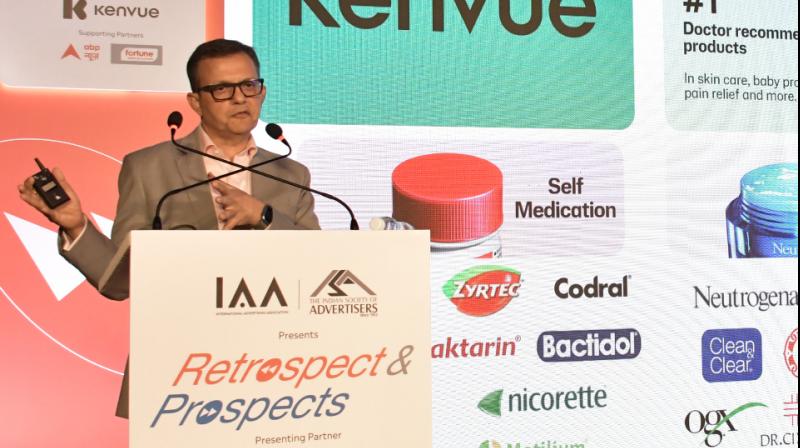While most of the companies and categories lost consumption due to inflation, consumer sentiment has come back up after a big drop, and now the industry has learned the importance of price-volume balance, said Manish Anandani, managing director - India, Kenvue, at the ‘Retrospect and Prospects’ event, hosted jointly by The Indian Chapter of the International Advertising Association (IAA) and The Indian Society of Advertisers (ISA), in Mumbai on 24 April.
Each year this event discusses the ‘highs and lows of the past year and future prospects of 2024.’
Change in consumption patterns and shopper’s behaviour
Setting the context of the topic, Anandani talked about India’s changing demographic landscape, focusing on the younger working population and the impact of nuclear families on consumption patterns.
He voiced, “The Indian economy is supposed to be 5 trillion by 2027 and is only going to get strong with time. The household saving percentage of GDP is coming down which means people can spend much more on consumption than they were spending earlier. By 2030, almost two-thirds of the population will be either millennials or GenZ and that will have a huge impact on the way we talk to the consumer as we go ahead. Also, the per capita consumption in the nuclear family is almost more than two times that of a large family and the number of categories that they are buying are also significantly higher.”
Citing India as a 'rising star,’ Anandani highlighted various segments of consumers that have come up in the market, in terms of income level. He mentioned the percentage of elite consumers will grow to 6% in 2027 from 3% in 2018 and the affluent consumers will grow from 21% to 38% in 2027.
“There’s going to be a huge difference in the way the consumption of the brands or the products is going to happen in the future. As the saving rate is coming down, consumer’s propensity to spend is going to get much higher. One of the biggest shifts in consumption is going to happen between food and non-food categories. Consumption is going to move from food - which is where most of the money was spent earlier, to the non-food categories,” he added.
Anandani stressed the emerging consumer segments, particularly affluent individuals who will be driving demand for premium products across categories.
He noted, “Three years back, the premium category contribution in baby care was less than 5% but today this category is at its highest at 25%. People are more willing to pay for a premium product. And that’s the part of the consumer segment which is impacting the consumption. Digital is going to be the way we do business and many times, we will have to choose between what is the best way to engage with the consumer, especially the premium segment, which will play a much bigger role.”
Implications of evolving consumer behaviour
Talking about the changing shopping behaviour, Anandani emphasised that influencer marketing, trend-based shopping, time-saving services and personalisation are the way to go.
Elaborating on the same, he said, “There is a huge impact of influencers. You need to have a plan to make sure you use influencers to drive behaviour change for shopping. The second change is about trend-based and time-saving services for shoppers who are looking for convenience. Also, customised personalisation is big now, especially in the beauty category. What is in it for me is becoming more important than anything else, right now.”
Highlighting the significance of purpose-driven sustainability initiatives to engage environmentally conscious consumers like Gen Z, he stated, “Gen Z are different, they are more aware, more discerning and more environmentally friendly than the previous generations have been. Given this massive opportunity with them, purpose and sustainability will need a stronger place and role in any campaign or marketing agenda, as we drive ahead.”
Anandani underlined the importance of leveraging digital platforms and influencer marketing to cater to evolving shopper behaviours towards personalised products and transparent brand communications.
He asserted, “We are seeing a rise of consumer activism, influencers leveraging the power of social media to question brands. What does this mean for the brands? This requires all brands to commit to the highest quality standards and deliver high-quality products and at the same time anticipate consumer demands and needs by offering innovative solutions before the problem arises. Another thing that is happening is brands which are social and influencer native brands, are winning."
Future trends
Sharing how India is not just one country, but many Indias, he said, “We need to win in ‘many Indias'. There is no 'one India'. The second thing is premiumisation and it is not about 10-15% of the price premium but about a different level of premiumisation. Sustainability is becoming important for all brands. Also, now it is really about transparency and science-backed brands. You need to have the right proposition and at the same time, you need to make sure that the right proposition is backed with a superior product that has unmet needs. And the last thing is the immersive experience. These things are very critical for the people, for the brands which are operating in any space.”
Concluding, Anandani shed light on the marketing strategies adopted at Kenvue. He also highlighted the point of brands with purpose, citing the example of the brand’s product Stayfree Secure Night.
“If you have a purpose for a brand and you can bring that purpose to life with the brand proposition, then consumers will connect very easily. And the second pillar is transparency,” he surmised.













